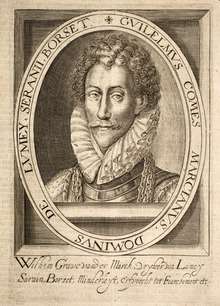William II de La Marck


.jpg)
William II de la Marck (Lummen, 1542 – Bishopric of Liège, 1 May 1578) (Dutch: Willem II van der Marck) was Lord of Lumey and initially admiral of the Watergeuzen, the so-called 'sea beggars' who fought in the Eighty Years' War (1568–1648), together with among others William the Silent, Prince of Orange-Nassau. He was the great-grandson of an equally notorious character, baron William de la Marck, nicknamed the "wild boar of the Ardennes".
On 1 April 1572 – the day of the Capture of Brielle – the Sea Beggars were led by De la Marck, and by two of his captains, Willem Bloys van Treslong and Lenaert Jansz de Graeff. After they were expelled from England by Elizabeth I, they needed a place to shelter their 25 ships.[1] As they sailed towards Brill, they were surprised to find out that the Spanish garrison had left in order to deal with trouble in Utrecht. On the evening of 1 April, the 600 men sacked the undefended port.[2]
On 9 July 1572 he executed the Martyrs of Gorkum, 19 Dutch Roman Catholic priests and religious who were ultimately canonized in 1865. Their crime was their refusal to abandon their belief in the Blessed Sacrament and in papal supremacy, even under torture. Lumey's action was contrary to orders he received from William the Silent.[3]
Having conquered South-Holland and controlling North-Holland and Zeeland, on 20 June 1572 Lumey was appointed stadtholder of Holland and consequently Captain General, i.e. military Commander in Chief of the conquered territories. It has never been evidenced that Lumey recognized either the authority or the seniority of the Prince of Orange, who was eventually recognized as the leader of the Low Countries' uprising against the King Philip II of Spain.
In 1576 Lumey was banned from the Netherlands, either by the States of Holland or the Prince of Orange. He is said to have participated in the lost Battle of Gembloux against the Spanish. He went back to his homeland, the Bishopric of Liège, where on 1 May 1578 he died in his residence on Mont-Saint-Martin. There are two different accounts offered for the circumstances of his death, one that he died of the bite of a mad dog or that he was poisoned while in prison.[4]
There is evidence that the earthly remains of William van der Marck are stowed away in a casket, that is bricked up in the Arenberg-family crypt under the former Capuchin Monastery Church at Enghien, today located in Belgium.
In popular culture
- He is featured as a recurring character in the Dutch comic series Gilles de Geus by Hanco Kolk and Peter de Wit.
- He also appears in Cecelia Holland's historical novel "The Sea Beggars", who changed some of the details of his life.
References
- ↑ Elliot, p. 139
- ↑ Elliott, p. 140
- ↑ Albers, Petrus Henricus. "The Martyrs of Gorkum" in The Catholic Encyclopedia. Vol. 6. New York: Robert Appleton Company (1909). Accessed 9 July 2013.
- ↑ Spalding, John (1875). "The History of the Protestant Reformation in Germany and Switzerland". Book. John Murphy & Company. p. 344. Retrieved 2015-01-18.
Sources
- Elliott, John Huxtable (2000). Europe Divided, 1559-1598 (2nd ed.). Oxford: Blackwell Publishing. ISBN 0-631-21780-0.